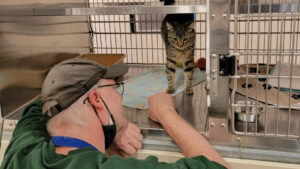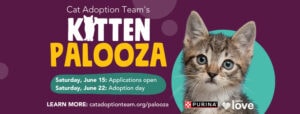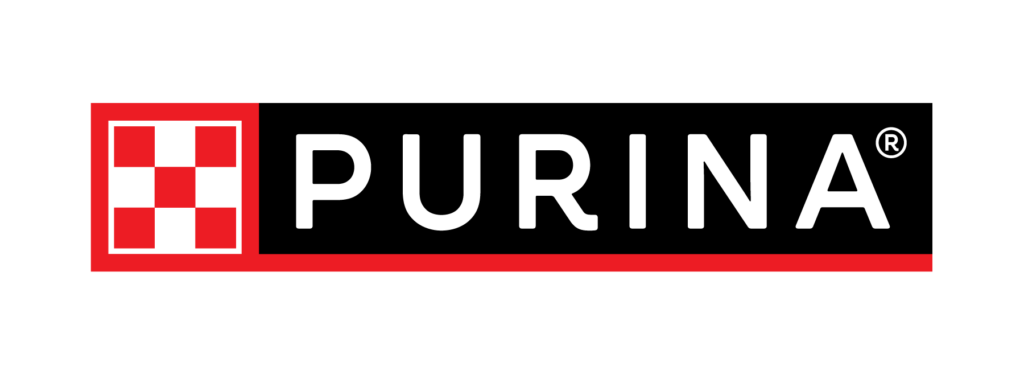Cat Adoption Team (CAT) offers food-dispensing toys to most cats in our shelter as part of our standard feeding routine. These toys, commonly called puzzle feeders, are a valuable way to improve cats’ daily life.
What is a puzzle feeder?
The term “puzzle feeder” refers to any interactive food-dispensing toy. A variety of food puzzles exists, and they typically fall into two categories:

- Mobile food puzzles are ball-, egg-, or tube-shaped and have one or more holes in them. You place dry food or treats inside the toy, and then the cat can roll the toy (by pushing with paws or nose) until the food inside falls out through the holes. With some puzzles, like the SlimCat™ ball toy, you can adjust the size and/or number of holes to make food release easier or more difficult. This ball toy is great for introducing your cat to puzzle feeders for the first time. (Bonus: you can purchase the SlimCat™ in person from our retail store and your proceeds will support CAT!)
- Stationary food puzzles use wet or dry food that is placed into cups, holes, tubes, or channels connected to a sturdy base. The cat might use their paw to fish out dry food or lick out wet food from inside the puzzle. The Catit® Senses 2.0 Digger has tubes that you fill with kibble or treats to encourage your cat to paw for food
You can make your own puzzle feeder at home using everyday items like paper towel tubes, egg cartons, or plastic water bottles. Our friends at Purina® offer step-by-step instructions for DIY puzzle feeders.
Why use a puzzle feeder?
Using a food puzzle helps mimic the natural way your cat would eat in the wild. After all, there are no bowls of kibble sitting around in the forest! Getting a meal on their own requires mental and physical stimulation—puzzle feeders bring some of that stimulation back to mealtime.
Puzzle feeders are a great way to improve your cat’s overall mental and physical well-being. Cat behaviorist Pam Johnson-Bennett offers these reasons to try puzzle feeding:
- Encourage your cat to eat slowly (may help with cats who are prone to vomiting from eating too quickly)
- Ease boredom
- Redirect your cat from engaging in destructive behavior
- Provide extra exercise
- Encourage your cat to think and stay mentally stimulated
- Healthier option to free-feeding
- Assist with weight control
How do puzzle feeders help shelter cats?
According to current guidelines for the care and welfare of domestic cats, domestic cats should have opportunities to express natural behaviors. Puzzle feeders, which make your cat work for food, are one way to mimic hunting behavior (also called “forage feeding”).
Puzzle feeders also encourage mental stimulation, which has been shown to decrease stress and anxiety—common issues for cats in an unfamiliar setting like a shelter. In a recent study about using puzzle feeders with cats, the researchers observed a variety of benefits, including weight loss, decreased aggression toward humans and other cats, and reduced anxiety and fear.
Not every cat is keen to use a puzzle feeder, and some cats take more time than others to acclimate to such toys. Because of this, we don’t feed every cat at CAT using a puzzle feeder. We choose the feeding option that will best match each cat’s specific needs and preferences.
This article is the first of a three-part series focused on enrichment opportunities for shelter cats.
References
(n.d.) Enrich Feeding Time: Make a Puzzle Cat Feeder. PurinaOne.com. Retrieved from https://www.purinaone.com/cats/articles/diy-cat-puzzle-feeder
Dantas, L. M., Delgado, M. M., Johnson, I., & Buffington, C. T. (2016, April 21). Food puzzles for cats: feeding for physical and emotional wellbeing. Journal of Feline Medicine and Surgery. doi: 10.1177/1098612X16643753
Ellis, S.L.; Rodan, I; Carney, H.C., et al. (2013, February 19). AAFP and ISFM feline environmental needs guidelines. Journal of Feline Medicine and Surgery. doi: 10.1177/1098612X13477537
Johnson-Bennett, Pam. (2013, May 15). CatBehaviorAssociates.com. Retrieved from http://www.catbehaviorassociates.com/why-does-my-cat-need-a-puzzle-feeder/






